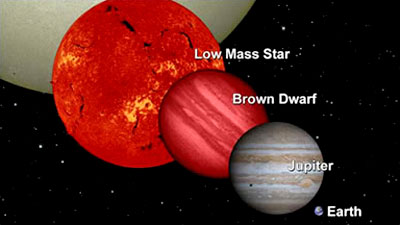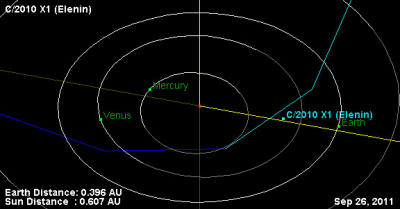|
from Exopolitics Website
Is Comet Elenin
really a Brown Dwarf? There has been growing scientific debate about Comet C/2010 X1 (Elenin) as it approaches the Earth, and its significance as it comes as close as 0.23 Astronomic Units -about one quarter the distance between the Earth and the sun - on October 16, 2011.
At one end of the spectrum are NASA
scientists claiming that Elenin is
little more than a comet
comprising icy space debris with negligible mass that will have
little effect on the Earth. At the other end are some scientists and
private researchers claiming that Elenin is a large planetary body,
possibly a brown dwarf star, and its near approach will have
calamitous effects.
Dr.
Mensur Omerbashich claims that
since 2006, comet Elenin has had a measurable impact on the Earth's
seismic activity. If Dr. Omerbashich is correct, then we can expect a
rapid surge in seismic activity in terms of major earthquakes as
Elenin approaches the Earth during the latter part of 2011.
His basic idea is that as planetary bodies align with the Earth, that seismic activity increases. He provides historic data on large earthquakes, greater than magnitude 6, and how these have occurred during planetary alignments. For example, he notes that the 9.1 earthquake that hit Indonesia on December 26, 2004 causing over 230,000 deaths around the Indian Ocean, occurred when the Earth, Mercury and Venus were in alignment.
At first, the planetary
alignment thesis seems puzzling since it's not obvious what is
happening during an alignment that would cause seismic behavior on
Earth.
The main
candidate for a viable response to this question is the "electric
universe" or "plasma cosmology" model.
Charges flow through this electric field by virtue of the plasma particles that are constantly being released by the sun (aka solar wind). Plasma is the fourth state of matter (solid, liquid, and gas being the first three) and comprises free protons, neutrons, electrons and ions that make up atoms.
Plasma is not electrically
neutral, but is a superconductor that can carry electrical charges
throughout the solar system (and indeed into interstellar and
intergalactic space)
In between, the electric field of the sun and the plasma
currents flowing from it through space, provide electrical charges
to planets, asteroids and comets depending on the nature of their
orbits and proximity to one another.
Fig 2
Plasma discharge -
note radial path of plasma Plasma discharges (see Fig 2) therefore regularly occur between celestial bodies.
When a comet moves close to a planet or the sun, the comet's electrical charge is significantly different in that region of the solar system's electrical field. The accumulation of charge and/or a plasma discharge subsequently occurs. For example, when comets travel close to the sun, plasma discharges (aka Coronal Mass Ejections) have been observed to occur.
Most astronomers are puzzled by such events which
they currently regard as mere coincidence. For supporters of plasma
cosmology, however, the sun's behavior when comet's approach is
evidence of the plasma discharge that regularly occurs when two
charged celestial bodies approach each other.
So now we can better understand how
planetary alignments might cause seismic activity which Dr. Omerbashich has observed in recent historical data.
In his paper, he writes:
Under the electric universe model, it is understandable how the sun would be so dominant in planetary alignments associated with large earthquake activity.
This is consistent with Dr. Omerbashich's own view that:
Similarly, the electric universe model helps explain why Mercury and Venus also play prominent roles in alignments associated with seismic activity on Earth. What's very important is noting that larger planetary bodies such as Jupiter, Saturn and Uranus, have not played prominent roles in planetary alignments.
Yet mysteriously, Elenin has.
Elenin's alignment
with Mercury and Earth on March 8, 2011 For example, on March 8, 2011, Elenin formed an alignment with the Earth and Mercury, 3 days before the devastating Japan magnitude 9 earthquake (see fig 3).
How can Elenin
play such a prominent role in seismic activity if it is just a small
comet with little mass as NASA argues?
There is, however, a major problem with the brown dwarf explanation.
If Elenin was a
brown dwarf, its huge mass (not yet known) and velocity of
approximately 50,000 miles per hour during perihelion of 0.46 AU
(closest point to the sun on September 10, 2011) would give it a
massive amount of momentum. Elenin's momentum would carry it far
past the sun and the inner solar system, well into the outer solar
system before the sun's gravity could slow and change Elenin's
direction enough to make it swing back past the sun in a very long
and narrow loop.
A brown dwarf would take far longer than the less than three
months it took for Elenin to change its direction by 90 degrees in
passing by our sun while within Earth's orbit. Fig. 4 Elenin's passage through the inner solar system
Passage of Elenin
through solar system Elinin's projected orbit into and out of the solar system shows that its path is similar to many long period comets where the sun swings it back almost 180 degrees (see figure 5).
The JPL simulation tells us that Elinin's momentum is not that large since the sun's gravity so quickly changes its direction. Elenin is therefore not a brown dwarf. Its 90 degree swing around the sun before passing the inner solar system suggests Elenin has the mass of a comet.
Yet paradoxically, Elenin's distant effect on Earth's seismic activity is similar to what would be expected of large planetary body.
So what exactly is Elenin?
Despite the paradox from the scientific data, one thing is clear from Dr. Omerbashich paper. Elenin's influence on seismic activity on Earth has yet to peak. As it approaches Earth, the planetary alignments with Earth will grow in intensity.
In this regard he writes:
So up to August 1, the incoming Elenin will be involved in further planetary alignments that lead to increased seismic activity on Earth, and then again from October 20 on its outward path.
Strangely, Dr. Omerbashich argues that between August 1 and October 20, seismic activity will diminish since Elenin will not,
Yet what he overlooks is what happens as Elenin passes directly between the Earth and the Sun.
Elenin directly
between Earth and Sun on September 26, 2011 On September 26, 2011 Elenin will pass between the Earth and sun and will be only 0.396 astronomical units from the Earth (see fig. 6).
Not the closest it will be to the Earth during its orbit, that occurs on October 16 (2011), but quite possibly the most significant for evaluating its seismic effect on Earth. According to the plasma cosmology model, the position of Elenin directly between the Earth and the sun will make it possible for the most powerful plasma discharge involving Elenin in relation to the Earth.
The plasma discharge is likely to
stimulate a spike in seismic activity during the August 1 to October
20 period when Dr. Omerbashich predicts seismic activity will wane. Fig 7
Elenin aligns with
Earth and Sun on Nov 23, 2011 Another date to watch is November 23, 2011 when Elenin and the Earth will again be in direct alignment with the sun.
This time Earth will be in the middle with Elenin only
0.596 AU away from the earth, and the sun on the other side (see
Figure 7). This alignment again makes possible a large plasma
discharge leading to seismic activity.
Elenin's quick 90 degree swing around the sun before passing Earth's orbit rules out the brown dwarf explanation.
Yet Elenin's influence on seismic activity on Earth suggests something more than a comet. Despite the paradox over Elenin's composition and influence, the scientific data points to it causing intense seismic activity as Elenin approaches and aligns with the Earth and other celestial bodies.
The dates of September 26 and
November 23, 2011 will be very important to watch in terms of high
magnitude earthquakes as Elenin swings in a 90 degree arc through
the inner solar system, and aligns with both the Earth and the sun.
|







